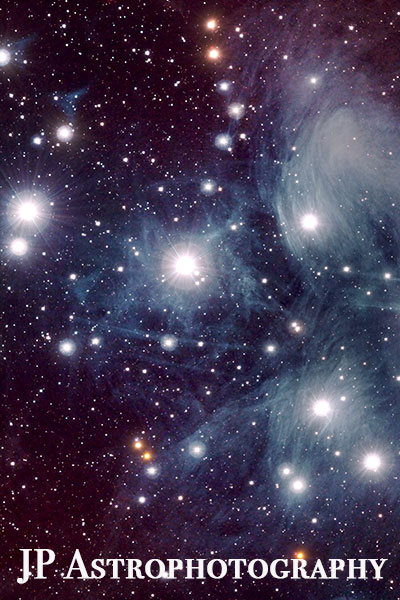
The stars depicted in the blog banner was taken by JP Astrophotography It is NGC6960, taken over 8 hours 51 minutes on 10/1-10/3, 540mm, full moon.
Night Shift With An Astrophotographer
Featuring Katie Anne of JP Astrophoto
Pleiades Cluster
Known by many names, the Pleiades Cluster, aka the Seven Sisters is an open cluster of hot blue stars.
An open star cluster is a group of stars that were formed by the same molecular cloud and have, roughly, the same age.
Pleiades’ cluster is estimated to have formed within the last 90-150 million years. With luminous blue stars that are most visible in the night sky during winter in the Northern hemisphere, Pleiades is the closest star cluster to Earth. It is easy to spot in the night sky, so it is no wonder that stories about this cluster have existed on Earth for over 100,000 years and from almost every continent.
“Pleiades is one of my favorite stargazing subjects It’s a group of stars so deeply connected to human history and storytelling. Ancient cultures from opposite sides of the world all share a common tale of seven young women in the sky (all missing their seventh sister) – and astronomers are starting to put together, based on the movement of the stars, that this might be a story that our human ancestors brought with them as they migrated around the world from Africa. Amazing.”
-Katie Anne from JP Astrophotography.
Galileo is credited as first glimpsing the the Pleiades through a telescope. He published a sketch of the Pleiades showing 36 stars in 1610, though the actual number of stars in the cluster is closer to 800 or more.
Astronomers know this deep sky object as M45, or Messier 45. Pleiades received this designation when the French astronomer included the cluster in his published astronomical catalogue, a study of 110 nebulae and faint star clusters eventually referred to as Messier’s objects.
The nine brightest stars of the Pleiades cluster are named for the Seven Sisters of the same Greek myth: Sterope, Merope, Electra, Maia, Taygeta, Celaeno, and Alcyone, as well their parents Atlas and Pleione.
Here in the Northern Hemisphere, the Pleiades star cluster is visible in the night sky until spring. Or, you can gaze upon the Seven Sisters any night (or day) of the year with this sweet cosmic print – original photo by local astrophotographer Jeff Palmer (of JPAstrophotography).
Keep looking up and stop by the blog next week for a very special edition of the Night Shift, just in time for Valentine’s (aka Vampire) Day!
Want these blog posts to come straight to your Inbox? Be a Cosmic Newsletter Subscriber.



